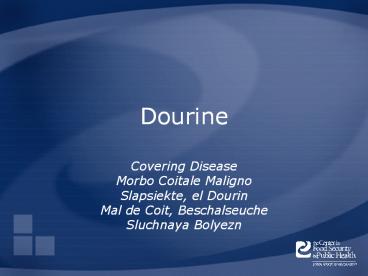Dourine - PowerPoint PPT Presentation
Title:
Dourine
Description:
Dourine Covering Disease Morbo Coitale Maligno Slapsiekte, el Dourin Mal de Coit, Beschalseuche Sluchnaya Bolyezn * * In today s presentation we will cover ... – PowerPoint PPT presentation
Number of Views:464
Avg rating:3.0/5.0
Title: Dourine
1
Dourine
- Covering DiseaseMorbo Coitale MalignoSlapsiekte,
el DourinMal de Coit, BeschalseucheSluchnaya
Bolyezn
2
Overview
- Organism
- History
- Epidemiology
- Transmission
- Disease in Humans
- Disease in Animals
- Prevention and Control
3
The Organism
4
The Organism
- Protozoan parasite
- Trypanosoma equiperdum
- Closely related to other Trypanosoma spp.
- T. brucei subsp. brucei
- T. brucei subsp. gambiense
- T. brucei subsp. rhodesiense
- T. evansi
- Strains vary in pathogenicity
5
Trypanosome
6
History
7
History
- Originated in Asia
- May have been introduced to Europe through
importation of stallions - Outbreaks reported in
- Germany
- France
- Austria
- Switzerland
- Algeria
8
History
- Introduced to North America
- Stallion imported from France in 1882
- Outbreaks occurred in
- Illinois (1886)
- Nebraska (1892 and 1898)
- South Dakota (1901)
- Iowa (1903)
- Canada (1904)
9
Epidemiology
10
Epidemiology
- Dourine once widespread
- Now eradicated from many countries
- Endemic
- Parts of Africaand Asia, including Russia
- Outbreaks
- Middle East
- Europe
11
Transmission
12
Transmission
- Transmitted during breeding
- Stallion-to-mare most common
- Occasional mare-to-stallion
- Found in
- Vaginal secretions
- Seminal fluid
- Exudate from the penis
- Non-infectious periods possible
- Parasites may temporarily disappear
- More common in late disease
13
Transmission
- Asymptomatic carriers
- Male donkeys
- Mare-to-foal transmission
- Before birth
- Through milk or mucous membranes
- No evidence of arthropod vectors
- Sexually immature animals
- Can transmit organism at maturation
14
Disease in Humans
- There is no evidence that T.
equiperdum can infect humans.
15
Disease in Animals
16
Species Affected
- Horses, donkeys, and mules
- Only natural reservoirs
- Zebras positive by serology
- Ruminants not susceptibleto equid isolates
- Experimental infection
- Dogs, rabbits, rats, mice
17
Disease in Animals
- Incubation weeks to years
- Symptoms variable
- Strain virulence
- Nutritional status
- Stress factors
- Signs may wax and wane
- Can occur several times before animal dies or
recovers
18
Disease in Animals
- Clinical signs
- Genital edema
- Mucopurulent discharge
- Vulvitis, vaginitis, polyuria
- Raised and thickened
patches on vaginal mucosa - Swollen membranes
- Can protrude through vulva
19
Disease in Animals
- Depigmentation
- Genital region, perineum, udder
- Abortion
- Edema of prepuce and glans penis
- May spread to the
scrotum, perineum,
ventral abdomen,
and thorax - Leukodermic patches
20
Disease in Animals
- Silver dollar plaques
- Skin, particularly over the ribs
- Pathognomonic
- Neurological signs
- Develop after genital edema,
or weeks to months later - Eventual paralysis
- Other signs
- Conjunctivitis, anemia, emaciation
21
Morbidity and Mortality
- Morbidity variable
- Chronic, mild disease
- Acute, severe disease
- Mortality
- Untreated cases 50 to 70
- Endemic areas
- Drug treatment may be possible
- Treatment may result in inapparent carriers
22
Diagnosis
- Clinical diagnosis
- Genital edema, neurological signs, silver dollar
plaques - Differentials
- Coital exanthema
- Surra, anthrax
- Equine viral arteritis
- Equine infectious anemia
- Contagious equine metritis
23
Diagnosis
- Serology clinical signs
- Complement fixation
- Prescribed test for international trade
- Used successfully in eradication programs
- False positives in uninfected animals
- ELISA, radioimmunoassay
- Counter immunoelectrophoresis
- Agar gel immunodiffusion
- Cross-reactions may occur
24
Laboratory Tests
- Parasite identification
- Definitive diagnosis
- Difficult to find
- Lymph, edematous fluids of external genitalia,
vaginal mucus, fluid contentof plaques - Detection more likely after edemaand plaques
first appear - Rarely found in thick blood films
25
Sampling
- Before collecting or sending any samples, the
proper authorities should be contacted - Samples should only be sent under secure
conditions and to authorized laboratories to
prevent the spread of the disease
26
Samples to Collect
- Serum
- Whole blood
- Blood smears
- Silver dollar plaques
- Aspirated fluid re-examine periodically
- Vaginal and preputial washings
or scrapings - 4 to 5 days after infection
27
Prevention and Control
28
Recommended Actions
- IMMEDIATELY notify authorities
- Federal
- Area Veterinarian in Charge (AVIC)
- http//www.aphis.usda.gov/animal_health/area_offic
es/ - State
- State veterinarian
- http//www.usaha.org/stateanimalhealthofficials.as
px - Quarantine
29
Prevention and Control
- New animals
- Quarantine
- Serological testing
- Cease breeding if detected
- Herd eradication
- Infected animals euthanized
- Stallions castrated
- Geldings can spread disease if they
display copulatory behavior
30
Prevention and Control
- T. equiperdum cannot survive outside a living
organism - Disinfection
- 1 sodium hypochlorite
- 2 glutaraldehyde
- 2 formaldehyde
- Heat at 50 to 60C
31
Treatment
- Successful treatment reported in some endemic
regions - Trypanocidal drugs
- Usually discouraged
- Likelihood of inapparent persistence
- Good hygiene should at assisted breedings
- No vaccine available
32
Additional Resources
- Center for Food Security and Public Health
- www.cfsph.iastate.edu
- USAHA Foreign Animal Diseases(The Gray Book)
- www.aphis.usda.gov/emergency_response/downloads/na
hems/fad.pdf
33
Acknowledgments
- Development of this presentation was made
possible through grants provided to the Center
for Food Security and Public Health at Iowa State
University, College of Veterinary Medicine from - the Centers for Disease Control and Prevention,
the U.S. Department of Agriculture, the Iowa
Homeland Security and Emergency Management
Division, and the Multi-State Partnership for
Security in Agriculture. - Authors Ariel Pleva, MPH Kerry Leedom Larson,
DVM, MPH, PhD, DACVPM Anna Rovid Spickler, DVM,
PhD - Reviewers Glenda Dvorak, DVM, MPH, DACVPM































